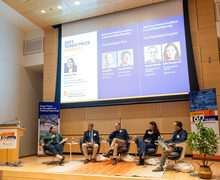Local refugees work to become self-sustainable through community gardens, urban farming
Colleen Ferguson | Senior Staff Writer
Refugee & Immigrant Self Empowerment (RISE)’s Syracuse Refugee Agriculture Partnership Program allows Syracuse refugees to learn Western farming techniques and how to create their own agricultural businesses.
UPDATED: April 22, 2019 at 6:26 p.m.
When Francis Muradi left his home in East Africa and came to the United States 11 years ago, he saw farming as a natural path to self-sufficiency in Syracuse. Farming is a way of life in his home country, he said. The first farm Muradi saw in the U.S. was the Lafayette location of Matthew 25 Farm, a not-for-profit charity that grows, harvests and distributes fresh produce throughout central New York.
Earlier this spring, Muradi walked the grounds of the farm once more. This time, he was looking at potential plots to grow crops on this season and asking the farm’s managers questions about things like irrigation methods.
“Our dream is to get our own farm,” Muradi said of he and his wife after the farm tour. “We can show (America) who we are.”
Muradi and his wife are two of the nearly 20 refugees participating in Refugee and Immigrant Self Empowerment’s Syracuse Refugee Agriculture Partnership Program. Through partnerships with local farms, businesses and agricultural groups, SyRAPP provides its farmers with resources they need to cultivate land and start their own farming businesses. The organization aims to promote a well-fed, self-sufficient population of area refugees.
Many SyRAPP participants have come from refugee camps, unfamiliar with the local systems and knowing little to no English, said SyRAPP program director Brandy Colebrook. This can be a traumatizing experience for them — but when the refugees come to the farm or garden, they’re in a better mood, she said.
“(We’re) giving them something to look forward to,” she added.

Amy Nakamura | Senior Design Editor
The program consists of community gardens — located on Seward Street and Lodi Street — and an incubator farm that doubles as a farmers market on Monday afternoons since it’s commercially zoned, Colebrook said. The incubator farm is located at Salt City Harvest Farm in Kirkville, where second- and third-year farmers can grow crops on individual quarter-acre or eighth-acre plots. RISE provides transportation to these farms once each week. But, people often took alternative methods of transportation out two or three times per week as well.
Part of the reason community gardens are so affordable in Syracuse is because of the Greater Syracuse Land Bank, Colebrook added. County property records show that the properties on Lodi and Seward Streets are both leased for $1 a year, eliminating virtually all of the costs associated with land acquisition. SyRAPP also receives help from Syracuse Grows, which offers free composting and mulch and pays SyRAPP’s city water bill, Colebrook said.
How the farmers use the available resources is completely up to them, Colebrook said, giving them the freedom to experiment and see what will grow well in Syracuse, including vegetables from their home country.
Having that autonomy is essential in the success of a program like SyRAPP, Colebrook said, since the end goal is for farmers to buy their own land and start their own business. Farmers are encouraged to try different things in the field, said Kayo Green, Cornell Cooperative Extension of Onondaga County’s urban agriculture educator.
Green teaches the business-focused classes farmers are required to attend as part of SyRAPP, which are modified depending on where the farmers are at in the program. SyRAPP conducts feedback sessions to help determine programming, Green and Colebrook said. Third-year farmers’ classes are based more on the marketing and business tools they’ll need to successfully sell crops, and students can also work with a local small business adviser, Colebrook said.
Once growing season starts, classes wind down so the farmers can focus on their field work.
Farmers often make mistakes during their first couple years in the program and may not be successful at first, Green and Colebrook said. This learning, though, is part of the process.
“The one big thing about a successful program like this, is just kind of letting people do their own thing and not trying to be too controlling or micromanage people,” Colebrook said.

Amy Nakamura | Senior Design Editor
Cheyenne Schoen, a graduate student in the David B. Falk College of Sport and Human Dynamics, conducted a qualitative study of SyRAPP to help Colebrook and Green assess its effectiveness among refugees in summer 2018. As part of her study, Schoen interviewed 11 farmers and four SyRAPP organizational team members about their experiences.
Through these interviews, she learned that first-year farmers felt frustrated by their limitations with the communal nature of the gardens, adding the requirement for first-years to farm in community gardens could be reconsidered.
She also noticed the refugees enjoying the social aspect of community gardening, and joined the refugees in the fields and made efforts to mimic their farming experiences. Schoen sustained a knee injury one day in the field.
“In that moment I was like, yeah, this is tough work,” she recalled.
Other hurdles farmers faced included disparities in the way crops grew, partly because many farmers were used to intercropping — planting different crops together to act against weeds and pests — in their homelands. Planting just one item with some of the same crops the refugees had grown before was not as successful in Syracuse, she said.
Schoen said RISE did a good job teaching refugees how to incorporate western farming techniques, like pest control, and how to fertilize soils in this climate. But a community garden or plot won’t solve all the challenges refugees face here, Schoen said.
“It’s not that simple and it can’t get at these root causes of what these people are going through, which is poverty, which is food insecurity,” she said.
Current and prospective SyRAPP participants toured available farmlands for this growing season, both at Salt City Harvest Farm and Matthew 25 Farm, on March 30. Several interpreters were present throughout the tours to communicate with the farmers in their native languages — just as there are interpreters at all of SyRAPP’s classes.
“We really want our farmers to feel understood,” Colebrook said.
Matthew 25’s farm administrator Elizabeth Esmark and farm manager Rick Rarick toured about two dozen people around the available land in Lafayette. Rarick told the group that Matthew 25 receives more than 100,000 excess plants each year from several local greenhouses and encouraged SyRAPP farmers to come take some.
“We’re here to feed people, we’re here to teach people, we’re here to encourage people to grow,” Rarick said.
Farmers can sell their crops at one of several farmers’ market locations throughout Syracuse, including the CNY Regional Market. This year is the first where SyRAPP will have its own stand at the regional market. Last year, farmers sold nearly 2,500 pounds of food and made about $750, Colebrook said.
Most farmers took home more crops than they sold, but that was their choice, she added. Colebrook said some saved hundreds in grocery expenses. One of the farmers went door-to-door with vegetables last growing season, giving food to needy families in his neighborhood.
Despite the hardships many of these refugees have endured, they display kindness like this often, Green said.
“They are very warm-hearted people, very patient to listen to and very hungry for enriching themselves and their lives,” she said.
CORRECTION: In a previous version of this post, the nature of the operation of the program was misstated. There is not a limited number of opportunities to use the bathroom. Also, the transportation was provided by RISE once a week, but people also had alternative means of getting to the farm. The Daily Orange regrets these errors.
Published on April 21, 2019 at 10:17 pm
Contact Colleen: cefergus@syr.edu | @ColleenEFergus2






